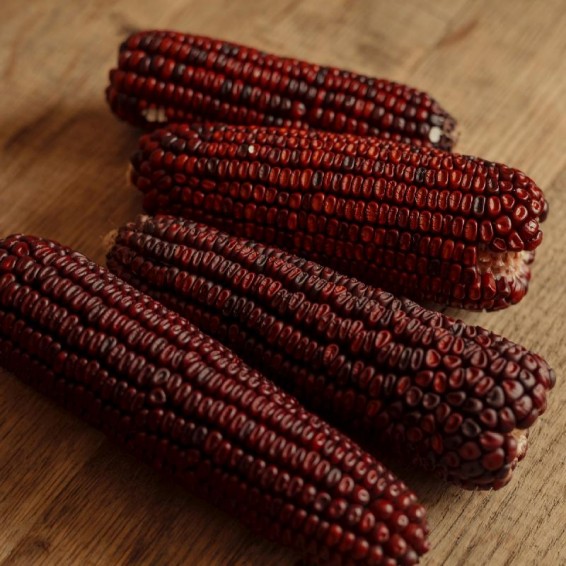Organic Bloody Butcher Ornamental Corn Seeds
- HOW TO GROW
- FAST FACTS
- REVIEWS
HOW TO GROW
Sowing: Prepare the soil with compost or other organic matter. One week after frost or when the soil consistently reaches 60 degrees F, plant the corn 1" deep. Planting blocks of four short rows ensures good pollination. Germination should take place in 5-6 days. For companion planting benefits, plant corn with cucumbers, peas, or pole beans; plants that like shade also do well with corn. Avoid planting tomatoes near corn.
Growing: After the corn emerges, keep it moist and carefully remove weeds; since corn cannot fight well against weeds, mulch may be beneficial. Additional organic matter or compost helps growth, since corn is a heavy feeder. Keep in mind that corn has shallow roots which can easily become damaged by hoeing. Watch out for pests, as corn attracts many problematic insects and animals.
Harvesting: Leaving the corn on its stalks to completely dry in the field gives the best results; when they are ready to harvest, the stalk and the ears will be completely brown with no green coloring at all. However, since continued rainy weather and humidity compromise the quality of the ears, it may be necessary to continue drying them inside. Choose a dry location with moderate heat, but out of direct sunlight; hang the stalks upside down, or lay them out flat.
Seed Saving: Since corn cross-pollinates quite easily with other varieties, seed plants will need to be separated from other pollinating varieties of corn by about 1,000 feet or otherwise prevented from pollinating each other. Allow the seed corn to dry completely on the stalk, until the husk and the stalk have turned brown. If rainy weather comes, cut off the stalks and lay them out in a dry, well ventilated location. Test for dryness by hitting a kernel with a hammer; if it shatters, the seed is ready for storage. Remove the kernels by running your hands over the cobs; winnow out the chaff. Store seeds in a cool, dry place.
FAST FACTS
Latin Name: Zea mays
Type: Open Pollinated, Heirloom, Warm Season
USDA Zones: 3, 4, 5, 6, 7, 8, 9, 10, 11, 12
Seeds per Ounce: 115
Planting Method: Direct Sow
Sunlight: Full Sun
Height: 120 Inches
Color: Red
Fast shipping
Very fast shipping and nice packaging I like the resealable package. I won't know more until this fall but thanks for the prompt delivery.
DESCRIPTION
HOW TO GROW
Sowing: Prepare the soil with compost or other organic matter. One week after frost or when the soil consistently reaches 60 degrees F, plant the corn 1" deep. Planting blocks of four short rows ensures good pollination. Germination should take place in 5-6 days. For companion planting benefits, plant corn with cucumbers, peas, or pole beans; plants that like shade also do well with corn. Avoid planting tomatoes near corn.
Growing: After the corn emerges, keep it moist and carefully remove weeds; since corn cannot fight well against weeds, mulch may be beneficial. Additional organic matter or compost helps growth, since corn is a heavy feeder. Keep in mind that corn has shallow roots which can easily become damaged by hoeing. Watch out for pests, as corn attracts many problematic insects and animals.
Harvesting: Leaving the corn on its stalks to completely dry in the field gives the best results; when they are ready to harvest, the stalk and the ears will be completely brown with no green coloring at all. However, since continued rainy weather and humidity compromise the quality of the ears, it may be necessary to continue drying them inside. Choose a dry location with moderate heat, but out of direct sunlight; hang the stalks upside down, or lay them out flat.
Seed Saving: Since corn cross-pollinates quite easily with other varieties, seed plants will need to be separated from other pollinating varieties of corn by about 1,000 feet or otherwise prevented from pollinating each other. Allow the seed corn to dry completely on the stalk, until the husk and the stalk have turned brown. If rainy weather comes, cut off the stalks and lay them out in a dry, well ventilated location. Test for dryness by hitting a kernel with a hammer; if it shatters, the seed is ready for storage. Remove the kernels by running your hands over the cobs; winnow out the chaff. Store seeds in a cool, dry place.
FAST FACTS
Latin Name: Zea mays
Type: Open Pollinated, Heirloom, Warm Season
USDA Zones: 3, 4, 5, 6, 7, 8, 9, 10, 11, 12
Seeds per Ounce: 115
Planting Method: Direct Sow
Sunlight: Full Sun
Height: 120 Inches
Color: Red
Reviews
Review
Fast shipping
Very fast shipping and nice packaging I like the resealable package. I won't know more until this fall but thanks for the prompt delivery.




